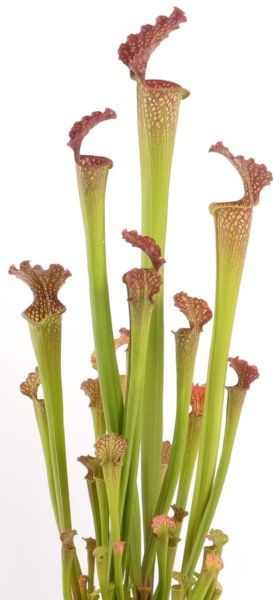North American Pitcher Plants (Sarracenia)
Last
updated: July 19,
2025
Care Sheet List
Sarracenia
are fascinating carnivorous plants native to the bogs and wetlands of
North
America. They are characterized by their unique pitcher-shaped
leaves, which act as pitfall traps to lure, capture, and digest
insects.
They are outdoor plants that require specific conditions to thrive.
Lighting
Sarracenia
require full, direct sunlight to grow healthily,
produce strong
pitchers, and display vibrant coloration.
- Ideal: A minimum of 6-8
hours of direct sun per day is essential, with 10-12+ hours
being even better.
- Placement: They are best
grown outdoors year-round. Place them in the sunniest spot possible,
away from any overhead obstructions. In Maltby, WA, this means the most
exposed, brightest location you have.
- Sign of good
light: Pitchers will
be firm, upright, and often show intense red, purple, or yellow
coloration (depending on the species/cultivar). Lack of sufficient
light leads to weak, floppy, pale green pitchers.
Watering
Routine
This is
perhaps the most critical aspect of Sarracenia care. They need constant
moisture and are extremely sensitive to minerals in water.
- Water Type: ONLY
use distilled water, rainwater, or reverse osmosis (RO) water.
Tap water, bottled spring water, and filtered water (like from a Brita)
contain minerals and salts that will accumulate in the soil and kill
the plant.
- Method: Use the "tray
method." Place the potted Sarracenia in a deep saucer or tray that is
kept continuously filled with 1-2 inches of pure water. This mimics
their boggy habitat and allows the plant to absorb water as needed.
- Frequency: Keep the tray
continuously full with water during the active growing season (spring
to fall). The soil should never be allowed to dry out.
- Dormancy: During winter
dormancy, reduce the water level in the tray so the soil remains damp
but is not constantly saturated.
Fertilizer
Requirements
NEVER
fertilize Sarracenia with traditional plant fertilizers.
- Their roots are
highly specialized for nutrient-poor, acidic bog conditions and cannot
tolerate the salts found in fertilizers. Fertilizers will quickly burn
their roots and kill the plant.
- They obtain all
necessary nutrients from the insects they catch in their pitchers.
- Feeding Insects: If grown
outdoors, they will naturally attract and catch enough insects. If
grown in an indoor greenhouse setting where insects are scarce, you can
drop a few live or dead small insects (like crickets or mealworms, no
larger than a third of the pitcher's opening) into some of the pitchers
once a month during the growing season. Do not overfeed.
Misting
Requirements
Sarracenia
appreciate high humidity, reflecting their native
bog environments.
- Beneficial: While good
watering practices (tray method) will help maintain local humidity
around the plant, additional misting is generally not necessary,
especially for outdoor plants.
- Consideration: If grown in a
very dry indoor environment (e.g., during winter, though outdoor
growing is preferred), high humidity is important to prevent pitcher
desiccation. A humidifier can be used.
Pot Size
and Soil Type
- Pot Size: Sarracenia
develop extensive root systems and can grow quite large. Choose a deep
pot, ideally 6-10 inches (15-25 cm) deep and at least 6-12
inches (15-30 cm) in diameter for a single mature plant, or a
larger bog garden container for multiple plants. Plastic pots are
generally preferred over terracotta, as terracotta can wick away
moisture and leach minerals. Ensure the pot has drainage holes
(required for the tray method).
- Soil Type: This is
absolutely critical. They require an extremely nutrient-poor,
acidic, and well-draining yet moisture-retentive substrate.
- NEVER use
standard potting soil, compost, or garden soil. These are fatal
to Sarracenia.
- The ideal mix is:
- 1 part Sphagnum
peat moss (ensure it is
pure, unfertilized peat moss, not peat moss with added nutrients or
"wetting agents").
- 1 part
Horticultural perlite (rinse the
perlite thoroughly before mixing to remove any potential mineral dust).
- Some growers
also add a small amount of horticultural sand (silica sand) for
improved drainage and aeration. Long-fibered sphagnum moss can also be
used.
Dormancy
(Absolutely Essential for Survival)
Sarracenia
species are temperate carnivorous plants and require a
distinct period of
winter dormancy (typically 3-5 months, from late fall through
early
spring). This is non-negotiable for their long-term survival.
- Timing: When
temperatures consistently drop below 50°F (10°C) in
late fall, growth will slow, and pitchers may turn brown and die back.
- How to Provide
Dormancy:
- Outdoors: In suitable
climates (USDA Zones 5-9/10, depending on species), simply leave the
plant outdoors. They can tolerate freezing temperatures. In very cold
areas or during extended deep freezes, some growers might use a layer
of pine needles or mulch for insulation, or move pots into an unheated
garage/shed if temperatures drop below 20°F (-6°C) for
prolonged periods.
- Water during
Dormancy: Keep the soil
damp, but reduce the water level in the tray significantly so the pot
is not constantly sitting in deep water.
- Do not trim
healthy pitchers during dormancy, as the plant
continues to photosynthesize. Only remove pitchers that have completely
browned and died back in spring before new growth begins.

